
|
 |
 |

|
 |
 |
The man who asks a question is a fool for a minute, the man who does not ask is a fool for life, Confucius
Antiderivatives are fundamental concepts in calculus. They are the inverse operation of derivatives.
Given a function f(x), an antiderivative, also known as indefinite integral, F, is the function that can be differentiated to obtain the original function, that is, F’ = f, e.g., 3x2 -1 is the antiderivative of x3 -x +7 because $\frac{d}{dx} (x^3-x+7) = 3x^2 -1$. Symbolically, we write F(x) = $\int f(x)dx$.
The process of finding antiderivatives is called integration.
The Fundamental Theorem of Calculus states roughly that the integral of a function f over an interval is equal to the change of any antiderivate F (F'(x) = f(x)) between the ends of the interval, i.e., $\int_{a}^{b} f(x)dx = F(b)-F(a)=F(x) \bigg|_{a}^{b}$
Calculating volumes with integrals is tricky and involves a variety of techniques such as slicing, the shell method, and the washer method.
To calculate the volume generated by revolving the curve y = x2 around the y-axis, we can use the method of cylindrical shells. The formula for finding the volume of revolution using cylindrical shells is: V = $2π\int_{a}^{b} x·f(x)dx$
Let’s calculate the volumen of each shell. Thickness = dx, height = a -y (where y = x2), base = 2πx, dV = (2πx)(a -y)dx = (2πx)(a -x2)dx = 2π(ax -x3), V =[y = a, y = x2 ⇒ x = √a] $\int_{0}^{\sqrt{a}} 2π(ax -x^3)dx = 2π(\frac{ax^2}{2}-\frac{x^4}{4})\bigg|_{0}^{\sqrt{a}} = 2π(\frac{a^2}{2}-\frac{a^2}{4}) = 2π\frac{a^2}{4} = \frac{π}{2}a^2$ -Figure 1.d.-.
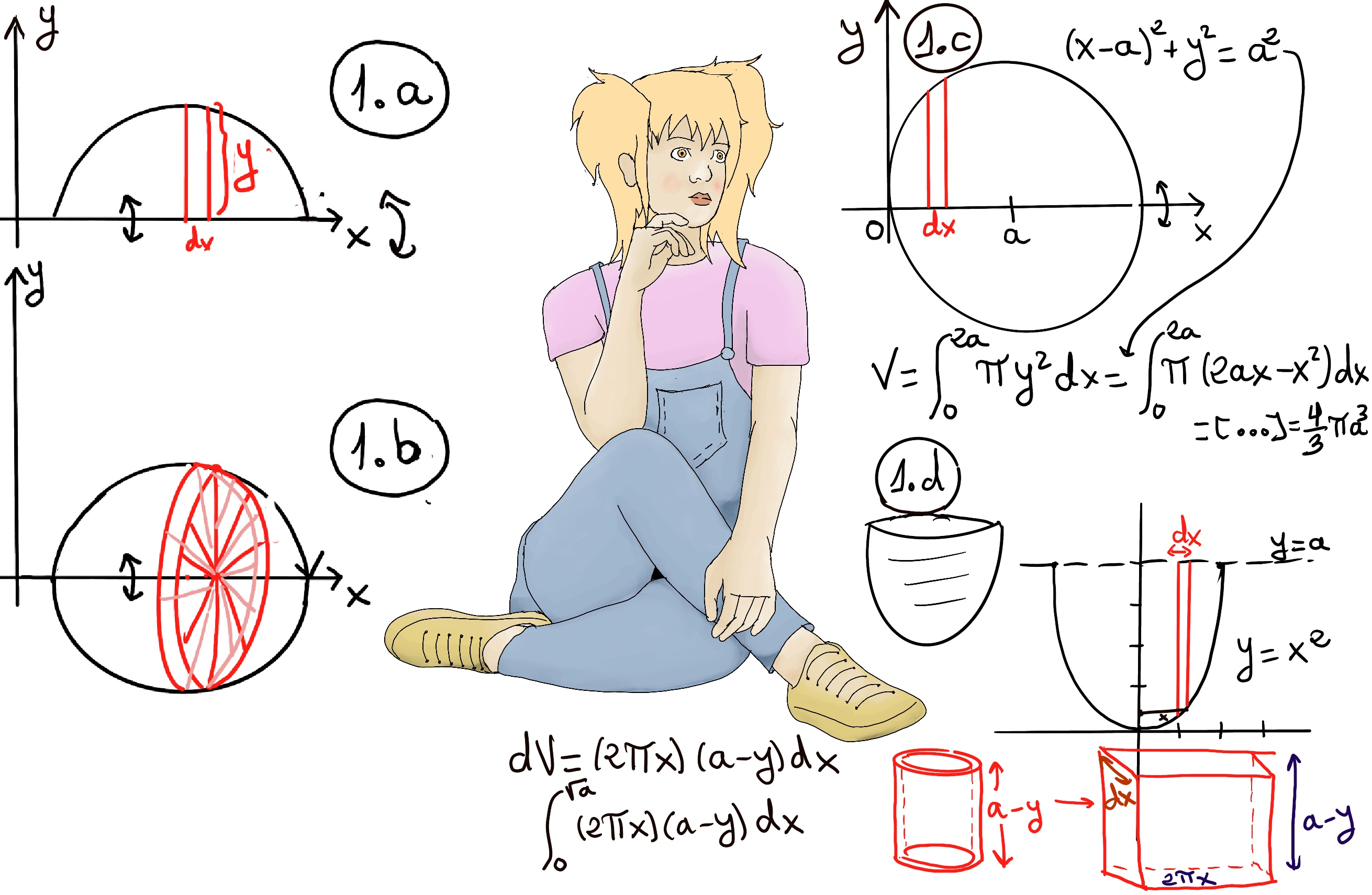
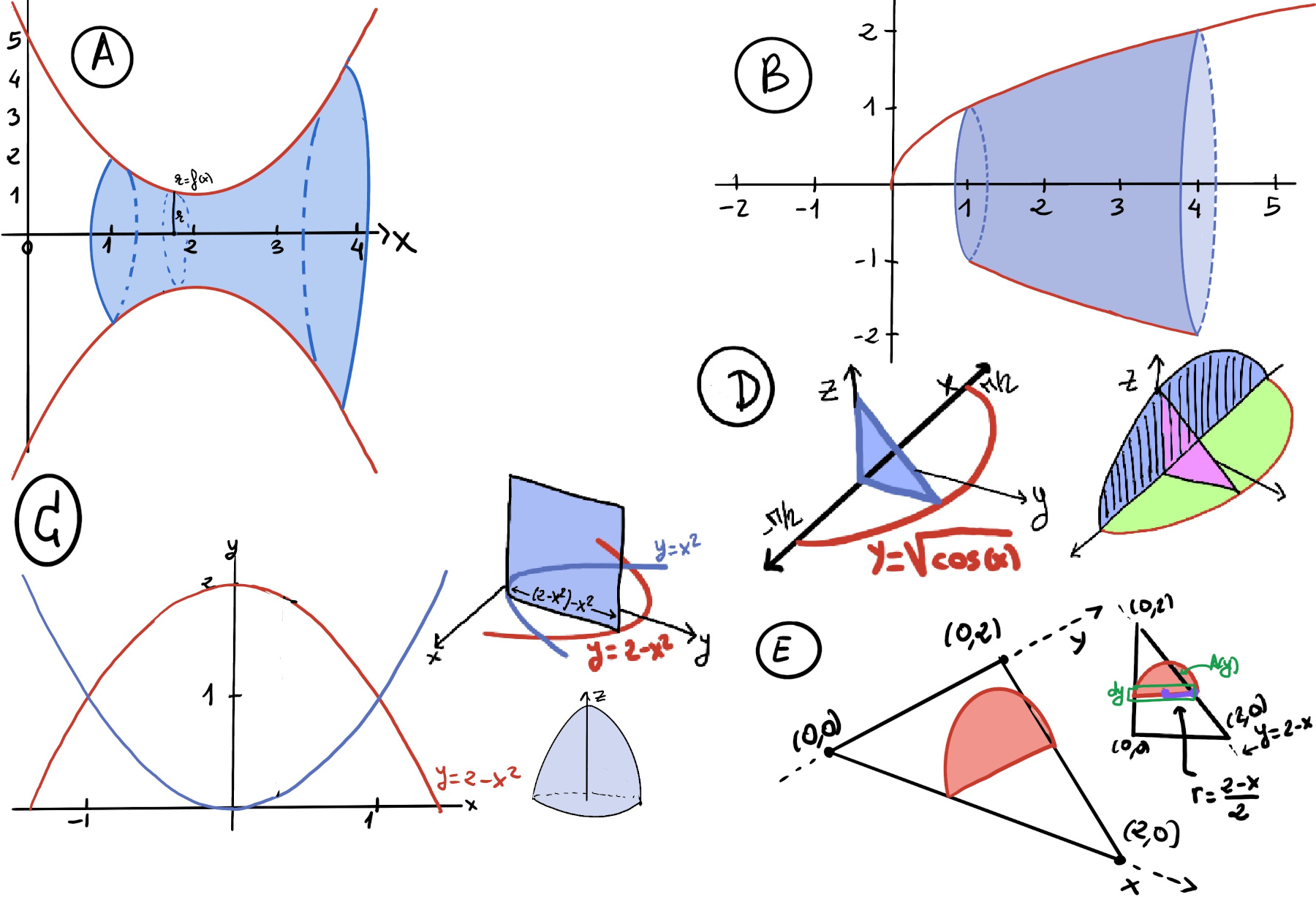
The solid of revolution is formed by revolving the region around the x-axis ⇒ the cross-sections are circles, A(x) = πr2 where r = f(x) = $\sqrt{x}$, and the volume is $\int_{1}^{4} πr^2dx = \int_{1}^{4} πxdx = π\frac{x^2}{2}\bigg|_{1}^{4} = π(\frac{16}{2}-\frac{1}{2}) = \frac{15π}{2}$.

Let’s calculate the points of intersections: $x^2 = 2 -x^2 ↭ 2(x^2-1) =0$ ↭ x = ±1.
V = $\int_{-1}^{1} A(x)dx$ =[By symmetry] 2$\int_{0}^{1} A(x)dx$ =[Each cross section is a square with side of length (2-x2)-x2] $2\int_{0}^{1} ((2-x^2)-x^2)^2dx = 2\int_{0}^{1} (2-2x^2)^2dx = 2\int_{0}^{1} (4 -8x^2 + 4x^4dx) = 2(4x-\frac{8}{3}x^3+\frac{4}{5}x^5)\bigg|_{0}^{1} = 2(4-\frac{8}{3}+\frac{4}{5}) = 2(\frac{60}{15}-\frac{40}{15}+\frac{12}{15}) = 2·\frac{32}{15} = \frac{64}{15}.$

We use the general slicing method to find the volume, V = $\int_{a}^{b} f(x)dx = \int_{\frac{-π}{2}}^{\frac{π}{2}} A(x)dx$[By symmetry] $2\int_{0}^{\frac{π}{2}} A(x)dx$ = [An isosceles right triangle is defined as a triangle with two equal sides known as the legs, a right angle, and two acute angles, A(x) = $\frac{1}{2}·\sqrt{cos(x)}·\sqrt{cos(x)}$] = $2\int_{0}^{\frac{π}{2}} \frac{1}{2}·(\sqrt{cos(x)})^2dx = \int_{0}^{\frac{π}{2}} cos(x)dx = sin(x)\bigg|_{0}^{\frac{π}{2}} = sin(\frac{π}{2})-sin(0) = 1.$
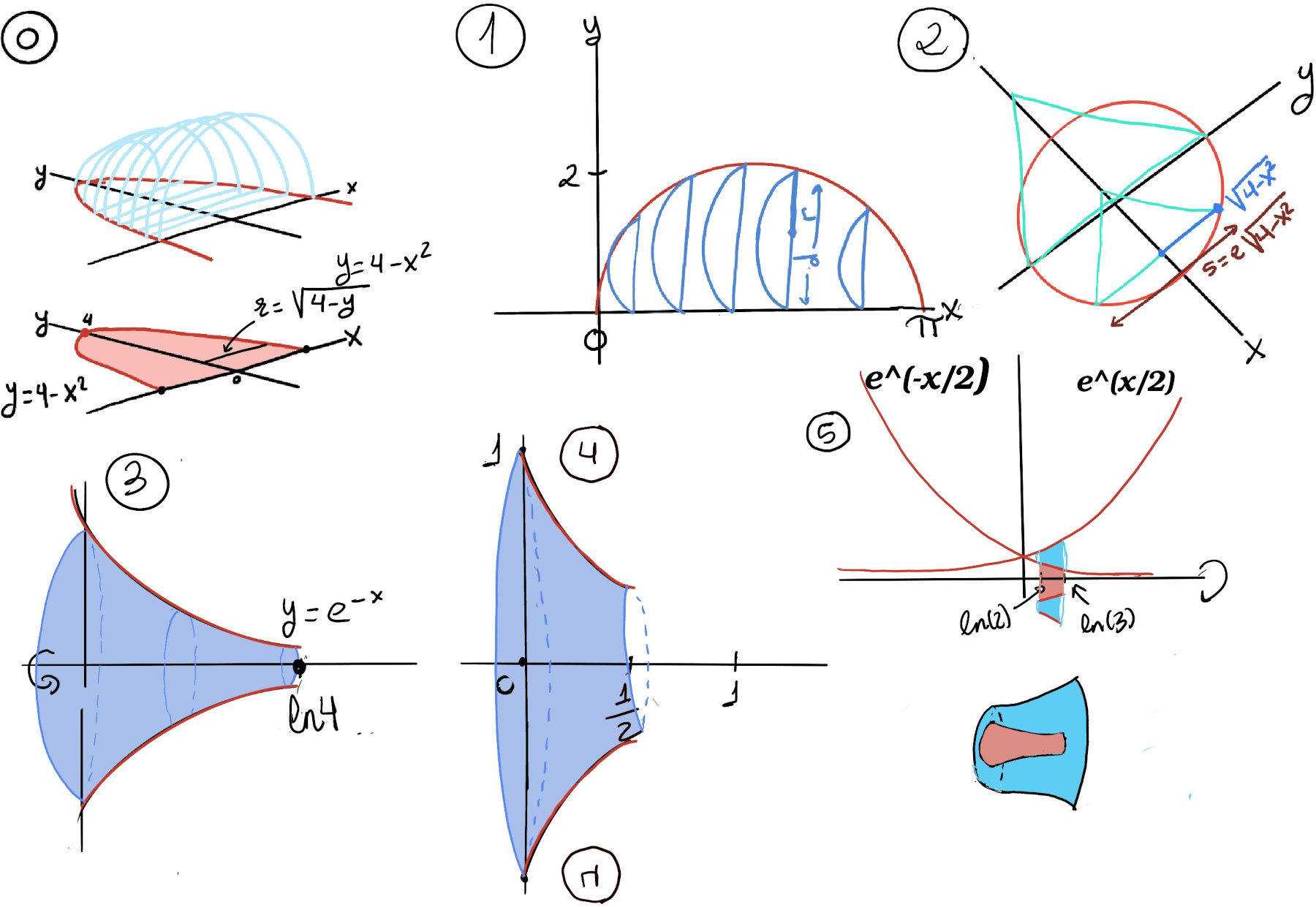
We have to use the washer method to find the volume of the solid formed by rotating two functions about an axis. The limits are logarithmic and are given in the question. We use the following formula: V = π·$\int_{a}^{b} (y_1^2-y_2^2)dx$
V = $\int_{ln(2)}^{ln(3)} π((e^{\frac{x}{2}})^2-(e^{\frac{x}{2}})^2)dx = π\int_{ln(2)}^{ln(3)} (e^x-e^{-x})dx = π(e^x+e^{-x})\bigg|_{ln(2)}^{ln(3)} = π(e^{ln(3)}+e^{-ln(3)}-(e^{ln(2)}+e^{-ln(2)})) = π(e^{ln(3)}+e^{ln(3)^{-1}}-(e^{ln(2)}+e^{ln(2)^{-1}})) = π(3+\frac{1}{3}-(2+\frac{1}{2}))=π(1+\frac{2}{6}-\frac{3}{6}) = π(1-\frac{1}{6}) = \frac{5}{6}π$
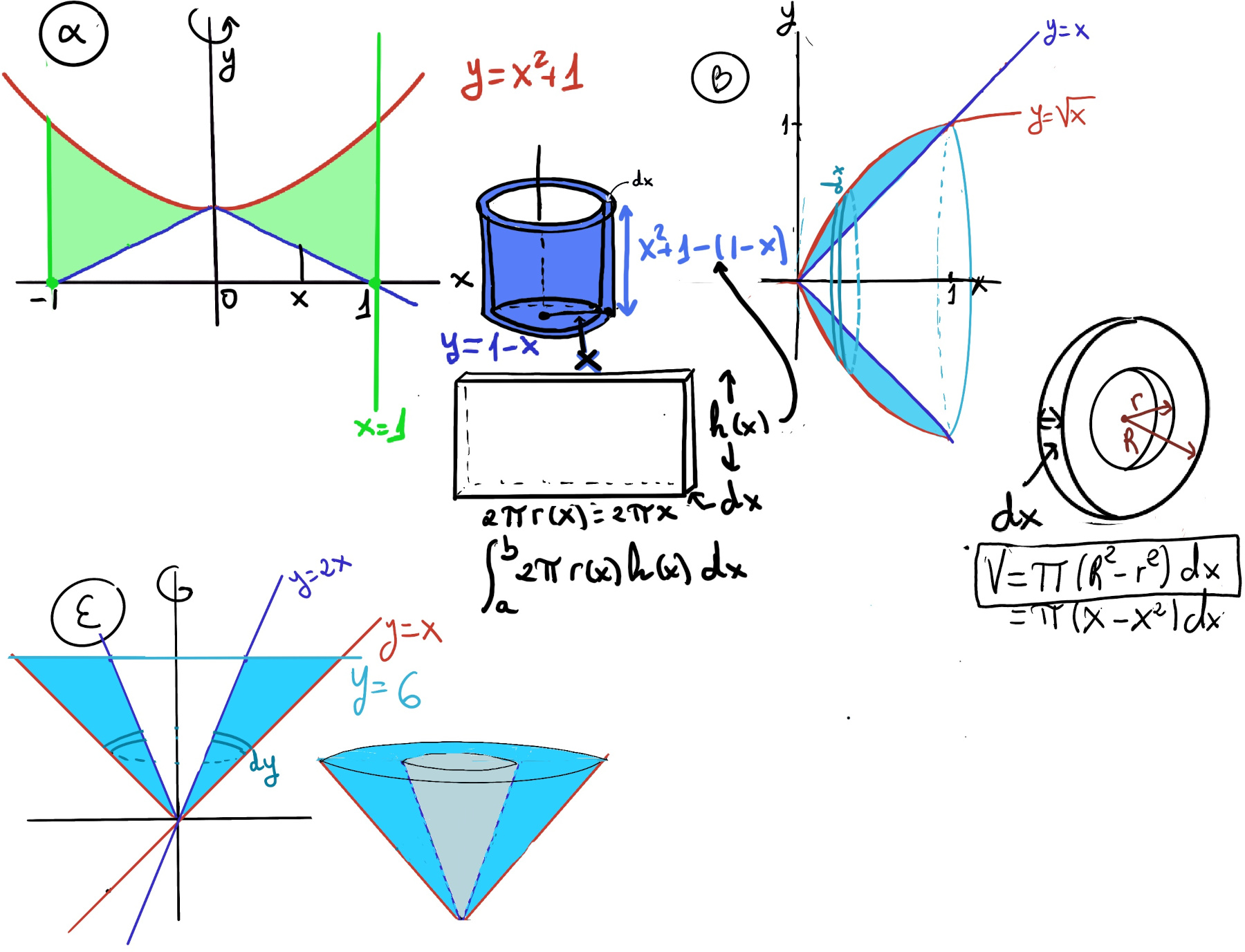
It is revolved about the y-axis, we can use the method of cylindrical shells. The volume of the solid formed by revolving a region R, bounded by x = a and x = b, around a vertical axis is $V = 2π\int_{a}^{b} r(x)h(x)dx$ where r(x) is the distance from the axis of rotation to x (the radius of the shell) and h(x) is the height of the solid at x (the height of the shell).

We must find the volume of revolution of y = $\sqrt{x}$ (V1) and subtract the volume of revolution of y = x (V2) (Figure β).
x-intercepts, $x = \sqrt{x} ↭(1st~quadrant)~ x^2 = x ↭ x(x-1) = 0$ ⇒ x = 0 and 1.
V1 = $\int_{0}^{1} π(\sqrt{x})^2dx - \int_{0}^{1} π(x^2) = \int_{0}^{1} πxdx - \int_{0}^{1} πx^2 = \int_{0}^{1} π(x-x^2)dx = π(\frac{x^2}{2}-\frac{x^3}{3})\bigg|_{0}^{1} = π(\frac{1}{2}-\frac{1}{3}) = π\frac{3-2}{6}= \frac{1π}{6}≈0.5236units^3$

V = $\int_{0}^{6} π(y^2-(\frac{y}{2})^2)dy = π\int_{0}^{6} (y^2-\frac{y^2}{4})dy = π\int_{0}^{6}\frac{3}{4}y^2dy = \frac{3}{4}π\frac{y^3}{3}\bigg|_{0}^{6} = \frac{3}{4}π\frac{6^3}{3} = \frac{216}{4}π = 54π ≈ 169.646units^3$
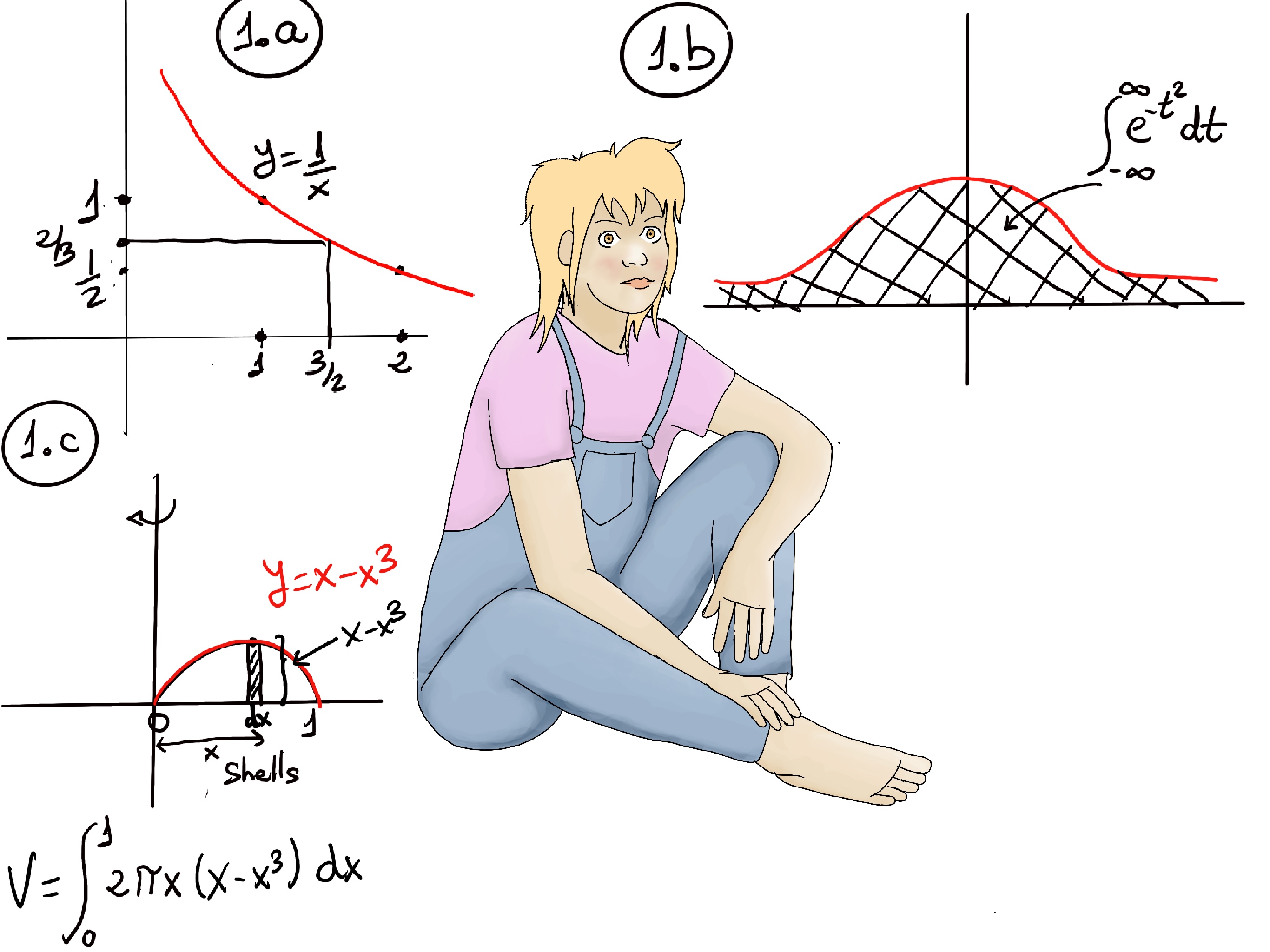
Solution: Figure 1.c.
Intersections of y = x -x3 and y = 0 ↭ x - x3 = 0 ↭ x(1 -x2) = 0 ↭ x = 0, 1 (we are working in the first quadrant).
V = $\int_{0}^{1} 2π(x-x^3)dx = π(x^2-\frac{x^4}{2})\bigg|_{0}^{1} = π(1-\frac{1}{2}) = \frac{π}{2}$.